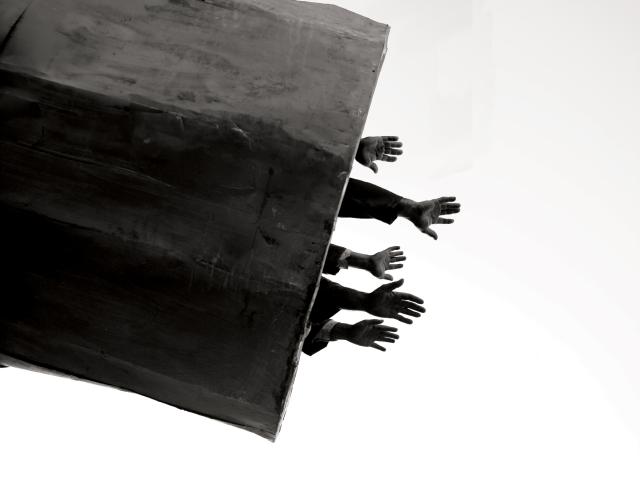KUTLUĞ ATAMAN
Born 1961 in Istanbul, Turkey. Lives and works in Istanbul.

Kutluğ Ataman, Mesopotamian Dramaturgies / Journey to the Moon, 2009, still photography, 31 x 41 cm. Courtesy of Francesca Minini, Milan and the artist
Kutluğ Ataman is a celebrated filmmaker and contemporary artist known for works that interrogate the ways in which people create, adapt and rewrite their own identities. His accomplished films and installations document and examine the lives of marginalised individuals. Ataman studied film and drama at California’s prestigious UCLA in the mid-1980s and made several experimental and feature films before shifting focus to contemporary art in the late 1990s. Born in Istanbul where he now lives and works, Ataman has spent time in America, the United Kingdom and elsewhere, and presents a critique of Turkish society in many of his works. He is a storyteller whose subjects include transvestites, opera singers, Hippeastrum plant collectors and entomologists, and his films examine the multifaceted experiences and obsessions of the outsider. In kutlug ataman’s semiha b. unplugged (1997), Ataman’s first film installation and one of the works that brought him to international attention in Manifesta 2 (1998) and the 5th Istanbul Biennial (1997), the artist presents an eight-hour portrait of the first Turkish opera singer, 87-year-old Semiha Berksoy. Berksoy’s eccentric musings create a strong impression that our lives can be fictions of our own making, and the work’s challenging length necessitates dipping in and out of the story – so that a definitive representation is denied. Ataman’s films favour conversation and monologue, variously presenting the stories of obsessive characters (an expert on Hippeastrum plants in The 4 Seasons of Veronica Read, 2002 and an insect collector in Stefan’s Room, 2004), outsiders (a black Jamaican living in Germany in It’s a Vicious Circle, 2002) and troubled, peripheral communities (stories of 40 individual residents in a marginalised Istanbul neighbourhood in Kuba, 2004).
Ataman’s understanding of film and attention to structure is complemented by the way viewers experience his works: multiple screens are placed in unconventional arrangements to enhance the already personal experience of watching these intimate stories – facing each other, encircling the room or arranged in unconventional ways. Placing them figuratively in conversation with themselves and/or the audience, the artist’s thoughtful installation of the screens is designed to echo some action or feeling conveyed in the films. In Kuba, 40 filmed interviews play simultaneously from old-fashioned televisions that face a mismatched assortment of armchairs, evoking the homelives of the shanty town subjects. Ataman’s use of editing and an accretion of filmic fragments highlight the composite, complicated nature of how our understandings of people and reality are formed.
Journey to the Moon (2009) forms part of Ataman’s recent eight-part series, Mesopotamian Dramaturgies, filmed in the rural region formerly known as Northern Mesopotamia. For this work, the artist seems to have ‘documented’ a rumour about a village in Eastern Turkey, four of whose inhabitants, at some time during the late 1950s, attempt to go to the moon using the tower of the local minaret as a rocket. The black-and-white found photographs that document this mythic narrative are projected alongside interviews in which a panel of established Turkish intellectuals, scientists and journalists comment on the story through the lens of their own academic disciplines. In this, as in many of his works, the lines between reality and fiction are blurred to underscore the constructed nature of history, reality, nationhood, fantasy and desire.
Selected Solo Exhibitions
2009 ‘Mesopotamian Dramaturgies’, Lentos Museum, Linz, Austria
2007 ‘Küba/Paradise’, Basis voor Actuele Kunst, Utrecht, The Netherlands 2006 ‘De-regulation with the work of Kutlu Ataman’, Museum van Hedendaagse Kunst (MuHKA), Antwerp, Belgium
2006 ‘Kutluğ Ataman: Perfect Strangers’, Museum of Contemporary Art, Sydney, Australia
2002 ‘Women Who Wear Wigs’, Istanbul Contemporary Arts Museum, Istanbul, Turkey
Selected Group Exhibitions
2007 ‘Footnotes on Geopolitics, Market and Amnesia’, 2nd Moscow Biennale of Contemporary Art, Moscow, Russia
2006 ‘Without Boundary: Seventeen Ways of Looking’, Museum of Modern Art, New York, USA
2004 54th Carnegie International, Carnegie Museum of Art, Pittsburgh, USA 2003 ‘Days Like These: Tate Triennial of Contemporary British Art’, Tate Britain, London, UK
2002 Documenta 11, Kassel, Germany
Selected Bibliography
Saul Anton, ‘A Thousand Words: Kutlu Ataman talks about 1+1=1’, Artforum 41, no. 6, February 2003, pp. 116–17
Rachel Campbell-Johnston, ‘Who do these people think they are?’, The Times, 23 March 2005, Arts section, pp. 1–2
Vasif Kortun, Fresh Cream: Contemporary Art in Culture, Phaidon Press, New York, 2000
Vasif Kortun, La Biennale di Venezia: 48a Esposizione internazionale d’arte, exhibition catalogue, Harald Szeemann (ed.), La Biennale di Venezia and Marsilio, Venice, 1999
Gregory Volk, ‘Captivating Strangers’, Art in America, February 2005, pp. 84–91




























